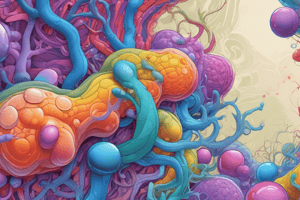Podcast
Questions and Answers
What is the main function of the cell membrane?
What is the main function of the cell membrane?
- To synthesize proteins
- To provide structural support
- To regulate movement of substances in and out of the cell (correct)
- To store genetic material
Which organelle is responsible for breaking down carbohydrates to produce ATP molecules?
Which organelle is responsible for breaking down carbohydrates to produce ATP molecules?
- Lysosomes
- Golgi Bodies
- Ribosomes
- Mitochondria (correct)
What is the function of the Rough Endoplasmic Reticulum?
What is the function of the Rough Endoplasmic Reticulum?
- To regulate calcium ions
- To store lipids
- To synthesize proteins (correct)
- To process toxins
What is composed of two subunits: the large subunit and the small subunit?
What is composed of two subunits: the large subunit and the small subunit?
What is the function of Vesicles?
What is the function of Vesicles?
What is the main function of Lysosomes?
What is the main function of Lysosomes?
What is the function of the Nuclear Envelope?
What is the function of the Nuclear Envelope?
What is the main function of the Nucleus?
What is the main function of the Nucleus?
What is the main function of the Nucleolus?
What is the main function of the Nucleolus?
What is the main function of the Golgi Bodies?
What is the main function of the Golgi Bodies?
Flashcards are hidden until you start studying
Study Notes
Cell Transport Mechanisms
- Diffusion and osmosis are types of passive transport, requiring no energy
- Active transport requires energy to move materials against a concentration gradient
- Factors affecting the rate of diffusion across a cell membrane include:
- Particle size
- Temperature
- Concentration difference
- Diffusion distance
- Smaller particles move faster than larger particles at a given temperature
Endocytosis and Exocytosis
- Endocytosis involves the uptake of materials into a cell through the formation of vesicles
- Types of endocytosis include:
- Phagocytosis (uptake of large molecules or cells)
- Pinocytosis (uptake of fluids and dissolved substances)
- Receptor-mediated endocytosis
- Exocytosis is the process of cellular secretion of macromolecules, where an intracellular vesicle fuses with the plasma membrane and discharges its contents outside the cell
Osmosis and Cell Environments
- Hypertonic solution: higher concentration of solutes and less water than the cell, causing water to leave the cell
- Isotonic solution: equal concentration of solutes and water as the cell, no net movement of water
- Hypotonic solution: lower concentration of solutes and more water than the cell, causing water to enter the cell
Cell Membrane Structure and Function
- The fluid-mosaic model of the cell membrane consists of:
- Phospholipid bilayer
- Embedded proteins
- Carbohydrate chains attached to proteins (glycoproteins) or lipids (glycolipids)
- The cell membrane is selectively permeable, controlling the passage of materials in and out of the cell
Cell Structures and Their Functions
Cell Membrane
- Selectively permeable to ions and organic molecules
- Controls movement of substances in and out of the cell
- Protects the cell from its surroundings
Mitochondria
- Eukaryotic membranous organelles that break down carbohydrates to produce ATP molecules
- Produce energy for the cell through respiration and regulate cellular metabolism
Endoplasmic Reticulum
- Smooth ER: regulates and releases calcium ions and processes toxins
- Rough ER: has ribosomes for protein synthesis on its surface
Ribosomes
- Composed of two subunits: large and small
- Both subunits are composed of rRNA and protein
Golgi Bodies
- Process and bundle macromolecules like proteins and lipids as they are synthesized within the cell
- Present in most eukaryotic cells and made up of membrane-bound sacs
Vesicles
- Cellular organelles composed of a lipid bilayer
- Function in metabolism and enzyme storage
- Used to transport materials from one place to another
Vacuoles
- Membrane-bound sacs within the cytoplasm of a cell
- Function in several different ways, including:
- Providing structural support
- Storage
- Waste disposal
- Protection
- Growth
Lysosomes
- Involved in digestion and waste removal
- Contain digestive enzymes
- Digest excess or worn-out organelles, food particles, and engulfed viruses or bacteria
Nuclear Envelope and Nucleus
- Nuclear envelope: double membrane structure surrounding the nucleus in eukaryotic cells
- Nucleus: contains the majority of the cell's genetic material, organized as DNA molecules and proteins to form chromosomes
Nucleolus
- Made up of proteins and ribonucleic acids (RNA)
- Function is to rewrite ribosomal RNA (rRNA) and combine it with proteins
Studying That Suits You
Use AI to generate personalized quizzes and flashcards to suit your learning preferences.



